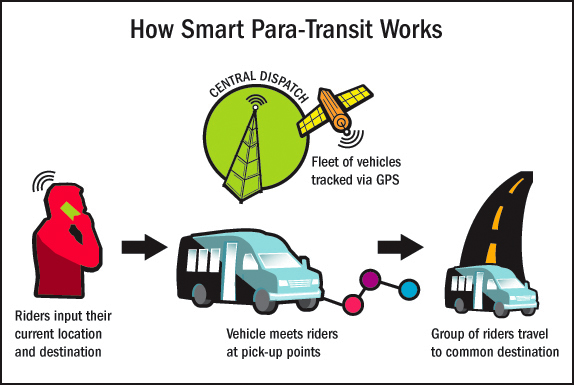Smart Para-Transit: Working Out the Details
This is the fifth and final installment of Mark Gorton’s essay on Smart Para-Transit. You can download the complete article here.

A regional Smart Para-Transit system would have many
operational elements. Dealing with all such details is far beyond the scope of this article, but I will touch upon some of the key operational issues. One of the biggest issues for such a system would be parking for the vehicles. However, space for these vehicles is available. Since one Para-Transit van can replace 5 private cars, only a moderate fraction of the existing space dedicated to private cars would be necessary for the Para-Transit fleet. The region is filled with parking lots and garages that are empty at night. Repurposing only a moderate fraction of these spaces would solve the parking issues of storing the fleet.
A large number of drivers would be required to pilot the
fleet of vehicles and demand for drivers and vehicles would be uneven over the
course of the day. The demand for drivers would be a benefit to the region bringing a large number of jobs to people with only a moderate education. Flexible scheduling policies could allow for some drivers to work only at peak hours and therefore be able to maintain multiple jobs.
Given that much of the travel demand is at peak hours, it
would make sense to have a significant fraction of the vehicles in the system
run only during rush hours. These
vehicles would make one trip into and out of the city each day just like a
regular commuter. It would be possible
to create a system where people who are regular commuters now could join a
program where they would switch their private automobile for a smart
para-transit van. These drivers would be
paid for taking a bit of extra time each day to pick up and drop off some other
people on their way to and from work. By
leveraging the time that drivers already spend on their trips, the necessity
for a large number of professional drivers would be minimized, and a great
natural efficiency would be gained.
Issues would also need to be decided as to who would own the
vehicles; manage, maintain and repair the vehicles; hire and train the drivers;
and all the other issues of running a fleet of vehicles. A centralized authority is not required to
manage the fleet. The only part of the
Smart Para-Transit system that needs to be managed centrally is the computer
information system. It might make sense
to have a hybrid government/private system for managing the fleet of vehicles. The dispatch of the private and government
managed vehicles would all be done by the central computer system, but the
actual management of any individual vehicle could be done by any of a number of
companies or agencies. The vehicles
could all be branded uniformly, so that the end customer would have no idea who
managed a particular vehicle. Maintenance, vehicle specifications, training, and cleanliness standards
could be centrally maintained and determined. In many ways, the NYC taxi system works in this fashion.
Investments would need to be made in computer systems,
support centers, maintenance depots, and the fleet of vehicles.
Many-fold
Benefits of a Smart Para-Transit System
The potential of Smart Para-Transit, combined with car
sharing, to remake New York City’s surface transportation system is breathtaking. New York could be changed from a traffic-choked
city to one where the majority of the streets are nearly traffic free the
majority of the time. Roads that are
permanently congested can be congestion free. The noise, stress, and danger that come with traffic can be radically
reduced. Streets once filled with
traffic congestion and parked cars can be reclaimed for human activity and
life.
Smart Para-Transit and car sharing need not be some far-off
dream. Pilot programs can be put in
place in as little as a year or two, and a full scale system can be running in
less than a decade.
Our current system is inadvertently designed to maximize air
pollution, maximize the waste of gasoline, maximize the production of CO2,
maximize the constant threat to children, and it penalizes more spatially
efficient forms of transportation such as buses and bikes. Adoption of a Smart Para-Transit system
combined with car sharing would result in huge quality of life improvements for
all New Yorkers. The radical reduction
in traffic around the city would give New York the opportunity to reclaim
excess road space for wider sidewalks, bike lanes, side walk cafes, pedestrian
streets, open air markets, benches, and many other street amenities. All New Yorkers would benefit from a greener,
cleaner, quieter, more peaceful, friendlier city. New Yorkers could again experience the vibrant
street life and rich sense of community that existed in New York before the
advent of the automobile.

